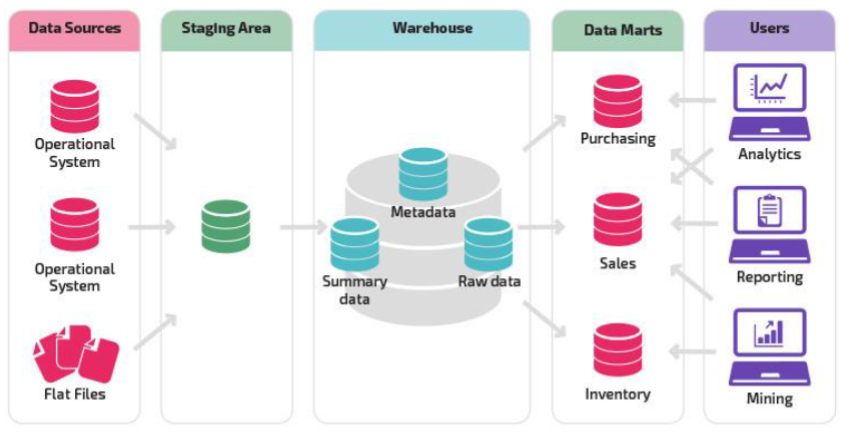Design & Develop: Data Warehouse & Data Mart for Business Organization
Keywords:
DW, DM, BI, Top-down analysis, Bottom-up analysis and IntegrationAbstract
Data warehouses (DW) are the foundation of business intelligence (BI) data storage. Business organizations utilize DW to help decision-making processes as large and complicated data sets must be examined and analysed. The analytical processing technology presupposes that data are presented as straightforward DM (data marts) with a well-defined set of facts and data analysis dimensions (star schema). Despite the widespread adoption of data warehouse technology and concepts, it becomes complex for the designers to identify and extract DM from an information system. This study strategy uses three fundamental steps for the methodology: top-down analysis, bottom-up analysis and integration. Though the method is not fully mechanical, it offers more direction than earlier methods to DW and DM designers.
Downloads
References
Adela, B., & Diaconita, V. (2009). A model for Business Intelligence Systems’ Development Adaptive Information Systems View project Intelligent system for trading on wholesale electricity market (SMARTRADE) View project. https://www.researchgate.net/publication/40646563
Awan, U., Shamim, S., Khan, Z., Zia, N. U., Shariq, S. M., & Khan, M. N. (2021). Big data analytics capability and decision-making: The role of data-driven insight on circular economy performance. Technological Forecasting and Social Change, 168, 120766. https://doi.org/10.1016/j.techfore.2021.120766
Božič, K., & Dimovski, V. (2019). Business intelligence and analytics use, innovation ambidexterity, and firm performance: A dynamic capabilities perspective. The Journal of Strategic Information Systems, 28(4), 101578. https://doi.org/10.1016/j.jsis.2019.101578
Brannigan, C., Harling, M., & Townend, M. (2016). The factors that influence decision making by 8-12 year olds in Child and Adolescent Mental Health Services (CAMHS): a systematic review. https://www.researchgate.net/publication/305787345
Faisal, S., Sarwar, M., Shahzad, K., Sarwar, S., Jaffry, W., & Yousaf, M. M. (2017). Temporal and Evolving Data Warehouse Design. Scientific Programming, 2017, 1–18. https://doi.org/10.1155/2017/7392349
Fink, L., Yogev, N., & Even, A. (2017). Business intelligence and organizational learning: An empirical investigation of value creation processes. Information & Management, 54(1), 38–56. https://doi.org/10.1016/j.im.2016.03.009
Graydon, C., Teede, H., Sullivan, C., de Silva, K., & Enticott, J. (2022). Driving impact through big data utilization and analytics in the context of a Learning Health System. In Big Data Analytics for Healthcare (pp. 13–22). Elsevier. https://doi.org/10.1016/B978-0-323-91907-4.00019-4
Gudfinnsson, K., Strand, M., & Berndtsson, M. (2015). Analyzing business intelligence maturity. Journal of Decision Systems, 24(1), 37–54. https://doi.org/10.1080/12460125.2015.994287
He, W., Shen, J., Tian, X., Li, Y., Akula, V., Yan, G., & Tao, R. (2015). Gaining competitive intelligence from social media data. Industrial Management & Data Systems, 115(9), 1622–1636. https://doi.org/10.1108/IMDS-03-2015-0098
Hurtado, C. A., & Gutierrez, C. (2007). Handling Structural Heterogeneity in OLAP. In Data Warehouses and OLAP (pp. 27–57). IGI Global. https://doi.org/10.4018/987-1-59904-364-7.ch002
Lechtenbörger, J. (2001). Data Warehouse Schema Design *.
Moody, D., Kortink, M., Moody, D. L., & Kortink, M. A. R. (2010). From Enterprise Models to Dimensional Models: A Methodology for Data Warehouse and Data Mart Design. http://sunsite.informatik.rwth-aachen.de/Publications/CEUR-WS/Vol-28/
Paradza, D., & Daramola, O. (2021). Business Intelligence and Business Value in Organisations: A Systematic Literature Review. Sustainability, 13(20), 11382. https://doi.org/10.3390/su132011382
Ramesh, G. S., Rajini Kanth, T. v., & Vasumathi, D. (2020a). A Comparative Study of Data Mining Tools and Techniques for Business Intelligence (pp. 163–173). https://doi.org/10.1007/978-981-13-8253-6_15
Ramesh, G. S., Rajini Kanth, T. v., & Vasumathi, D. (2020b). A Comparative Study of Data Mining Tools and Techniques for Business Intelligence (pp. 163–173). https://doi.org/10.1007/978-981-13-8253-6_15
Rouhani, S., Ashrafi, A., Zare Ravasan, A., & Afshari, S. (2016). The impact model of business intelligence on decision support and organizational benefits. Journal of Enterprise Information Management, 29(1), 19–50. https://doi.org/10.1108/JEIM-12-2014-0126
Shanks, G., & Bekmamedova, N. (2012a). Achieving benefits with business analytics systems: an evolutionary process perspective. Journal of Decision Systems, 21(3), 231–244. https://doi.org/10.1080/12460125.2012.729182
Shanks, G., & Bekmamedova, N. (2012b). Achieving benefits with business analytics systems: an evolutionary process perspective. Journal of Decision Systems, 21(3), 231–244. https://doi.org/10.1080/12460125.2012.729182
Sharda, R., Delen, D., & Turban, E. (2015). Business Intelligence and Analytics: Systems for Decision Support, 10th Edition.
Wang, H., Xu, Z., Fujita, H., & Liu, S. (2016). Towards felicitous decision making: An overview on challenges and trends of Big Data. Information Sciences, 367–368, 747–765. https://doi.org/10.1016/j.ins.2016.07.007
Wieder, B., Ossimitz, M. L., & Chamoni, P. (2013). The Impact of Business Intelligence Tools on Performance: A User Satisfaction Paradox? Business Intelligence Research at UTS (Accounting).
Williams, S., & William. (2007). The Profit Impact of Business Intelligence. Elsevier. https://doi.org/10.1016/B978-0-12-372499-1.X5000-5

Downloads
Published
How to Cite
Issue
Section
License
Copyright (c) 2023 Farhad Khoshbakht, Atena Shiranzaei, S. M. K. Quadri

This work is licensed under a Creative Commons Attribution-ShareAlike 4.0 International License.
All papers should be submitted electronically. All submitted manuscripts must be original work that is not under submission at another journal or under consideration for publication in another form, such as a monograph or chapter of a book. Authors of submitted papers are obligated not to submit their paper for publication elsewhere until an editorial decision is rendered on their submission. Further, authors of accepted papers are prohibited from publishing the results in other publications that appear before the paper is published in the Journal unless they receive approval for doing so from the Editor-In-Chief.
IJISAE open access articles are licensed under a Creative Commons Attribution-ShareAlike 4.0 International License. This license lets the audience to give appropriate credit, provide a link to the license, and indicate if changes were made and if they remix, transform, or build upon the material, they must distribute contributions under the same license as the original.





